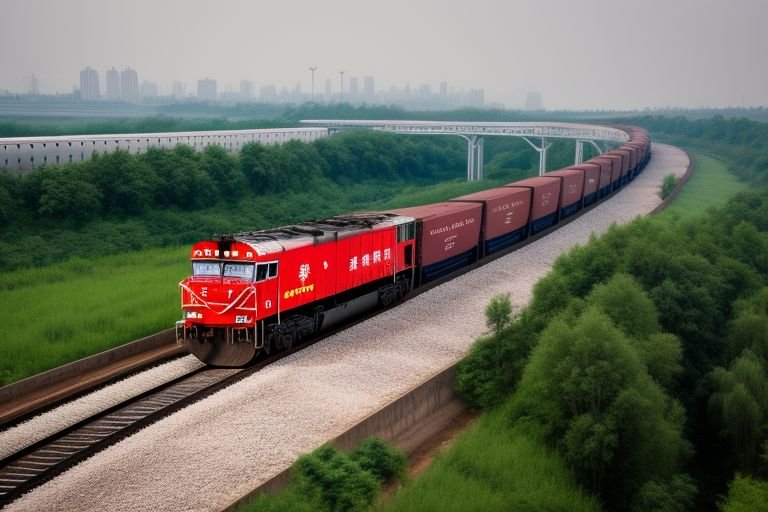PSCRP-BESA Reports No 118 (March 11, 2025)
Russia, which a dozen years ago aspired to be a major transportation corridor from the Pacific to the Atlantic, is gradually turning into a transportation and logistics desert. The new joint Chinese-Kazakh railroad project has become another stepping stone to exclude Russia from transcontinental logistics chains. At that, Russia loses not only Europe and the Far East as customers and partners: it also loses its leverage in the region it used to consider its fiefdom – namely, Central Asia.
According to the press-service of Kazakhstan Railways, as part of the project, which was launched jointly with the Chinese China Railway Container Transport (CRCT), container trains from the PRC will go through the territory of Turkmenistan, Kazakhstan, Iran and Turkey, and from there – to European countries. The first train on the new route departed from the Chinese city of Chengdu with the final destination in the Polish industrial center of Lodz, the estimated travel time is forty days.
This does not bode well for Russia. Up until the outbreak of the war against Ukraine, cargo from China to Europe mainly traveled through Kazakhstan, Russia and Belarus. However, after the Russian invasion, many companies refused to transit through Russian territory—apparently not only for moral and ethical reasons. There are real fears, if not of physical destruction of cargo, then of very likely problems with Russian customs and other security agencies, which can detain shipments on the most bizarre grounds.
In 2022, after the imposition of harsh international sanctions, the Russian leadership rushed to loudly proclaim the reorientation of its economy towards partnership with China. It seems that the Russian Federation, as usual, missed the memo. It has made itself completely dependent on China, allowing the latter to dictate the terms of the partnership, while the priority markets for Chinese exports remain in the United States and Europe.
According to Eurostat, China is the world’s largest exporter of goods: in 2023, it exported goods worth 3,125 billion euros (17.5% of world exports). It is followed by the EU (€2,557 billion, 14.3%), the United States (€1,869 billion, 10.4%), Japan (€663 billion, 3.7%) and South Korea (€585 billion, 3.3%).
In terms of imports, China ranks third (€2,364 billion, 12.8%), preceded by the United States (€2,934 billion, 15.9%) and the EU (€2,523 billion, 13.7%) and followed by the United Kingdom (€732 billion, 4.0%) and Japan (€727 billion, 3.9%). As we can see, Russia is not in the lead in terms of either exports or imports. This is despite the fact that from 2021 to 2023, imports from China to Russia grew by 121 percent (compared to exports from China to the rest of the world over the same period, which grew by 29 percent), according to the Atlantic Council.
Heavily sanctioned Russia, with its aging and impoverished population, will continue to remain on the periphery of China’s foreign trade balance even with full dependence on China. At the same time, China will seek to minimize its risks in other markets by excluding Russia from logistics chains. Central Asian countries are becoming China’s natural partners in this regard, and not only for purely geographical reasons. After the collapse of the USSR, a significant number of European, predominantly urban population left the region, which, among other reasons, caused a wave of urbanization of the indigenous population. Given the high birth rate and natural population growth, which, according to experts, will continue until the middle of this century, local markets are becoming the focus of attention of major trading powers, primarily China.
Russia however is rapidly losing influence in the region. Central Asian governments are also closely watching the weakening of the CSTO (the way Russia bluntly refused to fulfill its obligations to Armenia during the Second Karabakh War will not soon be forgotten). Russia’s blatantly discriminatory policy toward labor migrants from Central Asia is not strengthening relations with the countries of this region either. Sanctions, war and economic stagnation are also forcing them to look toward more reliable, profitable and promising partners. As a result, Central Asian countries and China are increasingly eyeing each other and turning away from Russia.
A natural consequence of this is the expansion of the partnership between Central Asia and China and the launch of new transportation and logistics projects. In addition to the above-mentioned new route from Chengdu, in early March it became known about the launch of a joint venture in Almaty between JSC Kedentransservice, the largest logistics terminal operator in the Republic of Kazakhstan, and China Xinjiang commercial logistics (Group) Co. Ltd. At the first stage they plan to create a modern complex with an area of 500 hectares and a design capacity of about 350 thousand TEU per year. The plans also include the construction of a railroad terminal, warehouse and multi-temperature zones, open areas for motor vehicles, as well as areas for bulk cargo and grain storage facilities.
And that’s not all: in addition, China is developing two more railroad projects through Central Asian countries, bypassing Russia. The first, the Trans-Caspian International Transportation Route (TITR), was agreed upon in the summer of 2023. It will pass through Kazakhstan, the Caspian Sea, Azerbaijan and Georgia.
The second involves the construction of a railroad through Kyrgyzstan and Uzbekistan to the Caspian Sea, from where cargoes will be delivered to the European Union via Turkey. The project will be implemented by China Railway International.
As for Russia, it will remain on the periphery of this new Silk Road, having finally lost its influence in the region and ceded its traditional spheres of influence to the new patron. All the while, the Russian leadership will continue to tell its population about the turn to the East and the struggle against migrants from Central Asia, whom the Russian public dislikes so much. Yet another cautionary tale of the fall of empires.
